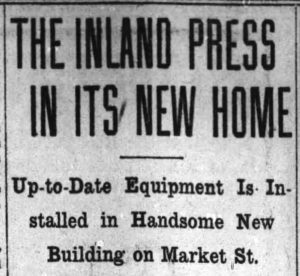The tall but narrow little pamphlets inevitably catch one’s eye on the shelf: each is only about 6 pages in length, and they are printed in bright colors and intriguing fonts on good paper. With almost four decades’ worth of issues, there is a lot to peruse. The series, Tips, is filled with sayings, words of wisdom, insider tips to succeed in business, and jokes. Such a charming and unusual publication provides the lure to discover much more about its story and reveals a much larger insight into life in Asheville, NC around the turn of the century.

Tips served as the long-lived house organ for the prolific Asheville-based publishing company The Inland Press. While Tips was the company’s house publication for some decades, with the first issue appearing in April 1909, the company also printed hundreds of books and pamphlets over many years, from collections of poetry to travel industry pamphlets, plus general kinds of office supplies, labels for products, and really anything that could be printed on paper. The North Carolina Collection at Wilson Library holds dozens of their publications.
From the earliest days of The Inland Press, the business garnered industry attention and accolades. The Typographical Journal (July 1, 1902, Volume 21, page 121) has a full-page feature advocating Asheville for the location of the 1903 convention of the International Typographical Union of North America. B. George Barber is stated to be the president of the union at this time, and the author asserts, “Our new president, Mr. Barber, is an artistic jobman, and is now doing a neat little business ‘on his own hook.’”
The Hill Directory for Asheville from 1904/05 has one, if not the earliest, city directory listing for a B. George Barber, printer, and Inland Press. Later directories and newspaper articles about the business would show that his brother, Frank, also joined the business and helped to run it for some time. Census records also show that B. George Barber was an Englishman and had immigrated to the States in 1881 when he was just a small child.

The city residents were apparently interested in the activities of The Inland Press, as local newspaper coverage over the years would indicate. In 1914, the Asheville Gazette-News reported that the shop had moved to no. 10 Market Street. Details abound as far as the layout of the building and the type of equipment found: six Platen presses, a monotype machine (said in the article to be the first in the state), and a “cutting edge” Babcock Optimus flatbed press. “The plant in its entirety is one that the owners are exceedingly proud of and one that brings credit to the city.”
The Linotype Bulletin, “Linotype Specimens Received” feature (March 1918, volume 14, page 109) states: “Effectiveness of the new lining gothics is well shown by a number of job specimens from B. George Barber, proprietor of the Inland Press, Asheville, N.C. Mr. Barber is a tasteful printer and directs the work of his Model 14 Linotype with skill and judgement. The little house organ, Tips, an entire Linotype product issued by the Inland Press, has this motto: ‘An idea at work is worth two in your nut.'”
The Asheville Citizen-Times continued to feature news about Inland Press. An article from May 3, 1919 announces that brother Frank A. will join the company, stating that the business had “steadily grown during the past few years until this firm has become one of the largest in the state.” Over the years, the paper would continue to document the growing business, including expansion. For example, July 8, 1919’s issue detailed the purchase of property from Edwin George Carrier to build a “three or four story modern printing establishment” on Spruce Street in Asheville. Other fascinating events in the history of the press include a 1921 union walkout. The striking printers said that the shop owners employed non-union members and refused to negotiate new contracts. A March 11, 1921 Citizen-Times article states that Mr. Barber has “only the kindest feelings for the union men who quit,” “but realized they were forced to do so.”
The growth of The Inland Press and the role of the Barbers in Asheville’s business and entrepreneurial community in the early 20th century is as fascinating a story as one that was printed in their shop. Tips can be found in the North Carolina Collection at call number C655 I56t.

It is so awesome that the Wilson Library holds some of their publications still! Makes me want to go scrounge them up! Thank you so much for this interesting nugget of history!